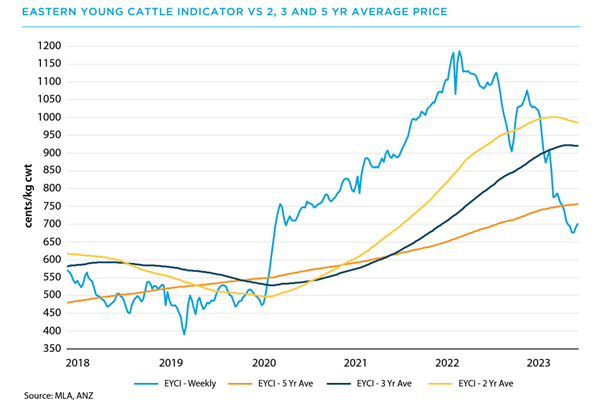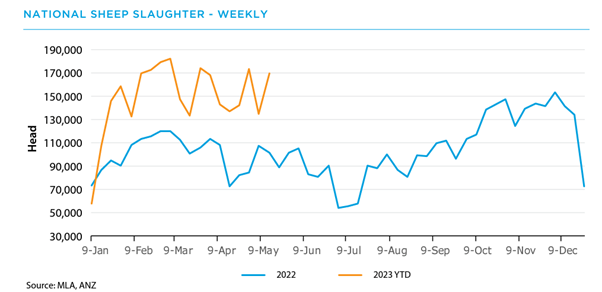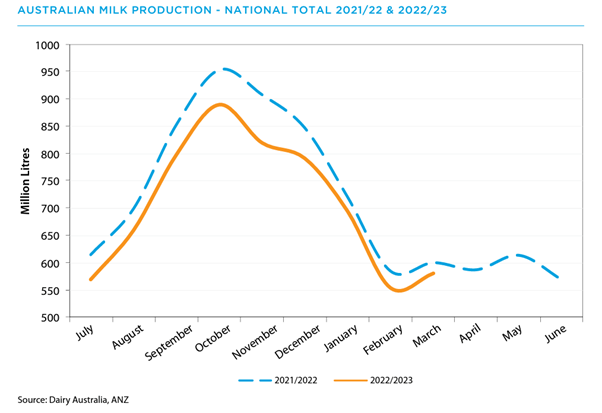-
This year brings new challenges for stakeholders right down the food supply chains, including farmer, processors, retailers and exporters.
A challenge for most major sectors is the peaking of the current price cycle for several key agri commodities. After having risen to record levels over the past two years, prices are correcting and returning to long-term average levels.
"After two years of optimal weather conditions for much of Australia’s agri landscape, the outlook heading into the second half of 2023 is not as positive.”
While this correction is likely to have been factored in by many strategic producers, it may nevertheless prove challenging for those who assumed it would continue.
Across livestock industries colder weather impacts both pasture development and animal growth. Farmers will closely be watching the conditions of their paddocks and making decisions around supplementary feeding and fertiliser application.
For grain producers, with the nation’s crop largely already sown, this time of year means monitoring the crop closely and applying supplements when needed to enhance the chances of a good harvest.
After two years of optimal weather conditions for much of Australia’s agri landscape, the outlook heading into the second half of 2023 is not as positive. This return to an average growing season is a second factor affecting the industry, along with the possible return of a drier El Nino weather pattern.
Despite the inevitable impact of other factors, such as rising interest rates and inflation, both domestic and global demand for Australia’s agri products remains strong - a trend likely to continue even with the northern hemisphere looking to its strongest cropping season in some years.
Beef
For the beef industry, the main talking point remains the major slide in cattle prices.
The industry benchmark Eastern Young Cattle Indicator (EYCI) fell by 50 per cent from January 2022. While on its own this may not be a concern, it is still arguably a predictable market correction.
{CF_IMAGE}
The intense buying competition from farmers wanting to restock after the last drought has eased as the national cattle herd approaches optimal levels.
Importantly, a lower cattle price is also a benefit for the meat processing sector which has limited ability to pass on the costs of expensive cattle to retailers.
In terms of exports, the demand for Australian beef exports remains strong, particularly to the USA where the cyclical rebuild of their herd has meant reduced domestic supply.
Cropping
Over the past three years, Australia has successively produced its three largest grain and oilseed crops ever, largely because of excellent growing conditions in most cropping regions in that time.
However, the national harvest is forecasted to return to average levels in the second half of the year. This is due to high likelihood of dry conditions. But harvesting is not scheduled to start until November so there is still plenty of time for conditions to change.
At the same time, while global grain prices have fallen sharply over the past 18 months, as the surge in prices driven by market nervousness around grain supplies due to the Ukraine conflict has subsided, the market remains vigilant to any shocks causing more supply issues.
Encouragingly, export demand for Australian grain remains strong, especially by China for wheat, with the industry hoping China’s tariffs on Australian barley may be lifted before too long.
Sheep
In many ways, the Australian sheep industry is experiencing similar cyclical impacts as the cattle industry with a post-drought return to a larger national flock reducing buyer competition and subsequently lowering prices, albeit to long term average levels. Over the past few years. Australian sheep prices have been boosted not just as a result of tighter supply following the drought but by a surge in global demand for sheep meat.
{CF_IMAGE}
This demand came particularly from China as it sought to access red meat as it rebuilt its pig herd following African Swine Fever as well as the US where both Australian lamb and mutton saw increased consumer demand. This strong export demand looks likely to continue although tighter economic conditions may reduce US demand to an extent.
Wool
The wool industry is one sector more likely to feel the impact of a global economic downturn given the product is seen to some degree as a luxury item and therefore a discretionary purchase. As has been the case for some time, the finer wool varieties – those which go into top end suits and clothing – continue to attract far higher prices than coarser wool which is more likely to be used for carpets and outerwear.
Optimistically, wool apparel imports appear to be picking up in major northern hemisphere markets, which may see a growth demand from processors boost Australian wool prices.
Dairy
The Australian dairy industry continues to contract with national milk production levels down on the previous year and the national milking herd continuing to decline.
{CF_IMAGE}
The decline is being driven by a number of factors including lack of labour, attractive offers for dairy land from beef producers and the sheer hard work of running a dairy operation. With the industry forecast to continue shrinking, this could pose increasing challenges for processors, retailers and exporters in terms of attracting adequate supply levels.
Globally, dairy product prices have remained strong, reflecting a continuing emergence from Covid restrictions, particularly in China, as well as the ongoing long-term growth in many Asian markets of consumer dairy consumption.
Michael Whitehead is Head of Agribusiness Insights at ANZ.
To view the full ANZ agri infocus commodity insights report 2023 click here
The views and opinions expressed in this communication are those of the author and may not necessarily state or reflect those of ANZ.
-
-
-
anzcomau:Bluenotes/Agriculture,anzcomau:Bluenotes/Agtech,anzcomau:Bluenotes/Commodities
Winter is coming for the agri commodity price cycle
2023-06-08
/content/dam/anzcomau/bluenotes/images/articles/2023/June/AgriOutlook23.png
EDITOR'S PICKS
-
For New Zealand agriculture, inflation remains a worry but China reopening brings hope.
22 February 2023 -
A decade after ANZ’s first Greener Pastures report into the future of Australian agriculture, a second edition reveals Australian agri has performed better than forecast and highlights the sector’s opportunities and challenges.
23 November 2022



